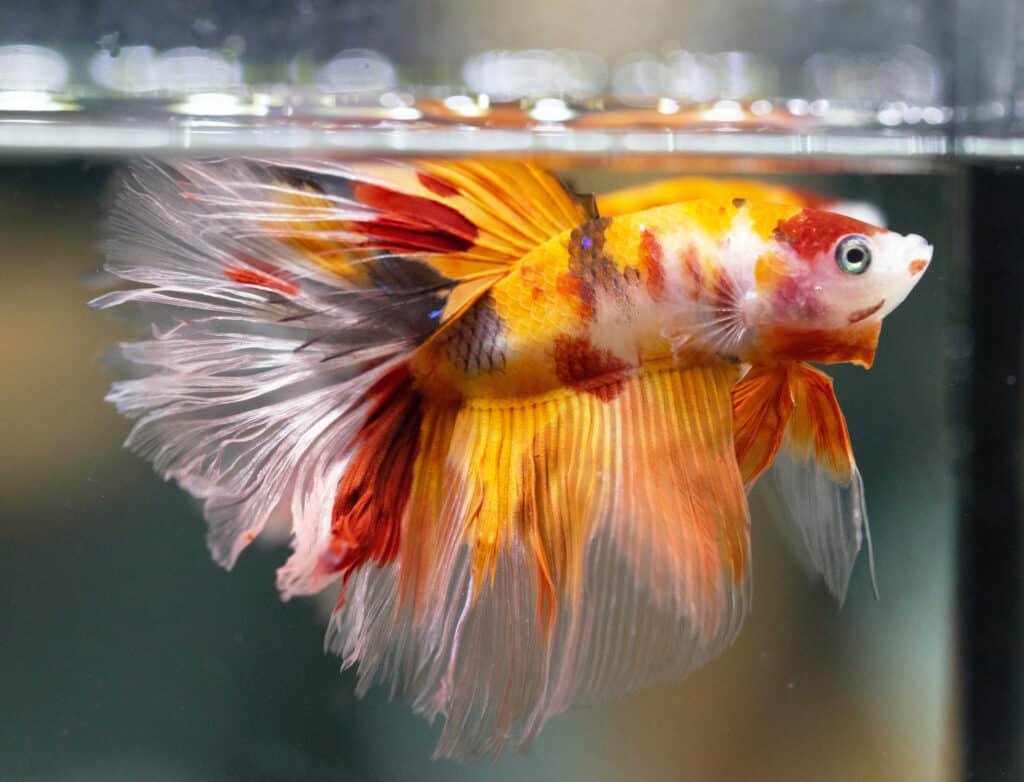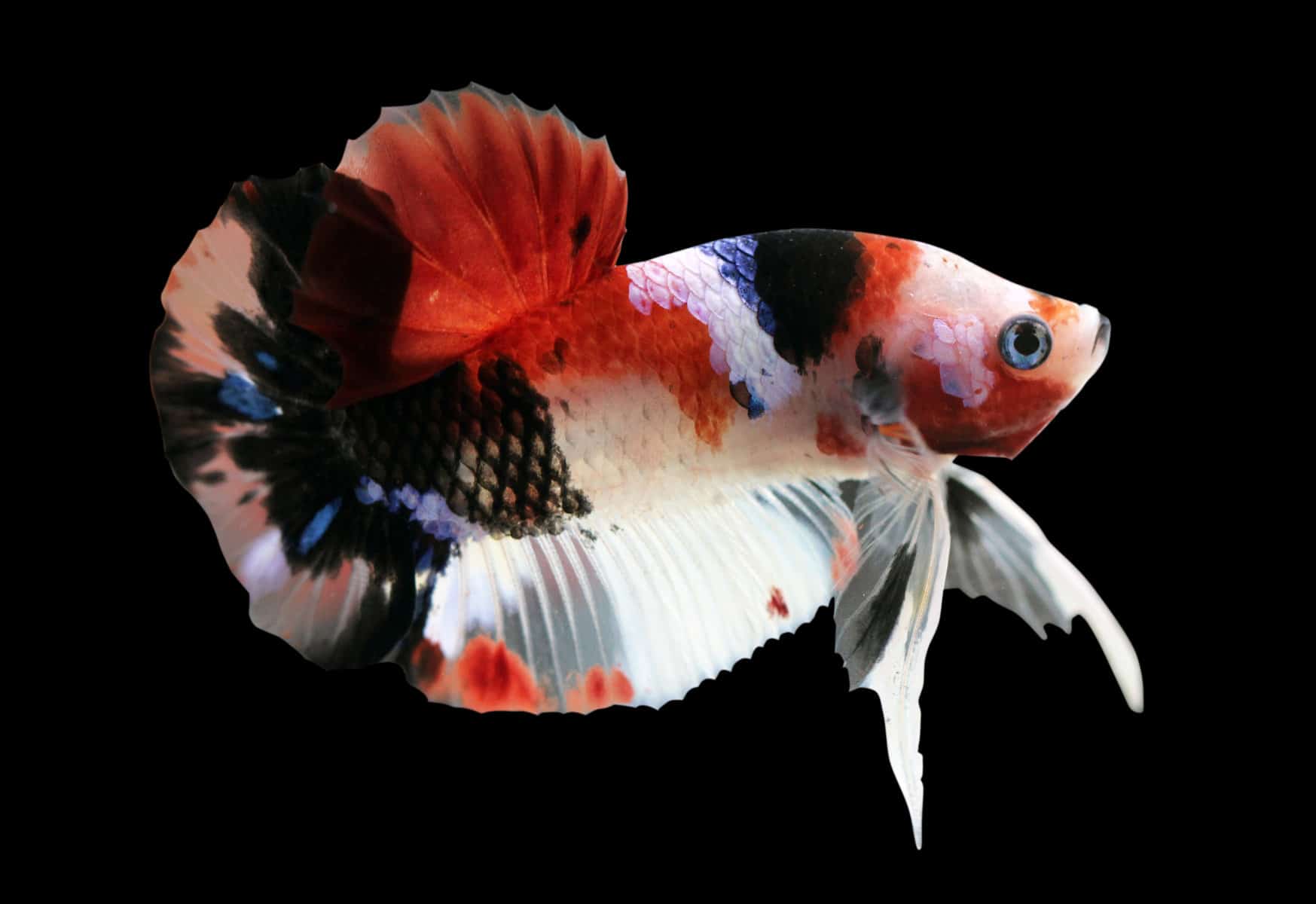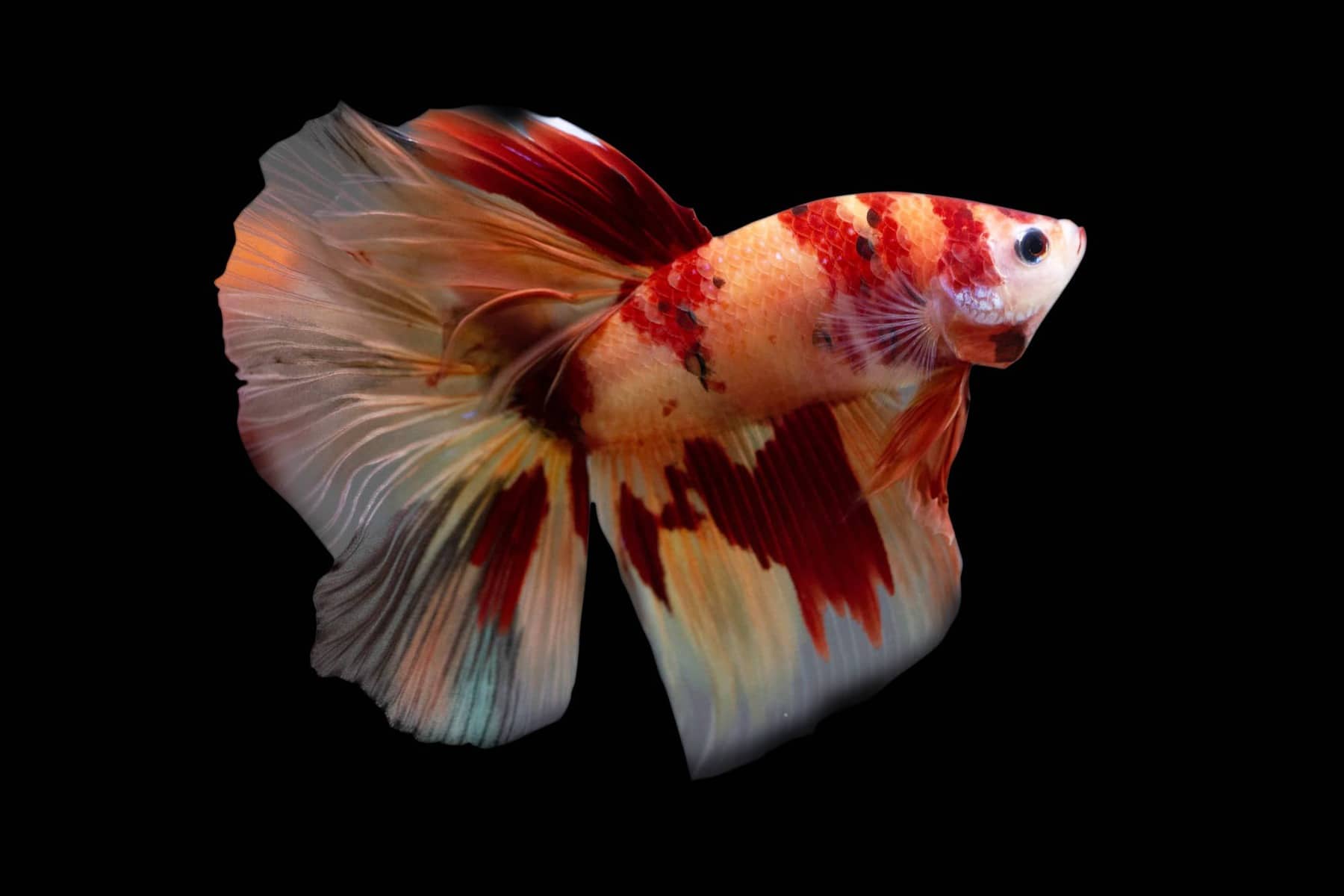Koi bettas are some of the most sought-after types of betta fish. Their unique marbled color patterns that gradually change and shift over time never get old!
There are also several types of koi bettas, with Galaxies, Halfmoon, and Plakats being the most popular. You can even keep an all-female sorority of koi betta fish.
But what makes this intriguing variety of betta so unique, and are they really related to koi carp? If you’d like to find out, keep reading!
Fact Sheet Information
| Koi Betta Info | |
|---|---|
| Common Names | Koi betta, Halfmoon Koi Betta |
| Scientific Name | Betta falx |
| Minimum Tank Size | 5 to 10 gallons |
| Beginner-Friendly | Yes |
| Breeding | Requires experience |
| Lifespan | 3-5 years |
| Diet | Omnivore but primarily carnivorous |
| Aggressive | Yes |
| Water Temperature | 78° to 81°F |
| pH Level | pH 6-8 |
| Water Hardness | 5 to 20 dKH |
Original Habitat
Koi bettas are a type of betta splendens or Siamese Fighting Fish. Betta splendens is originally from the rice paddies and shallow pools of South East Asia.
However, the ancestors of koi bettas have been in captivity for a very long time! One thousand years of selective breeding have produced exotic varieties with elaborate patterns and enormous fins, that now hardly resemble their wild ancestors at all.
The History and Background of Koi Bettas
The koi betta belongs to the marbled betta subgroup of betta splendens. These marbled bettas were first bred in the 1970s and started out in only black and white colors, but as time went on, breeders developed a vast array of colors.
Eventually, some black, white, and reddish specimens were produced that were reminiscent of the famous koi carp, which became known as the koi betta.
But it didn’t stop there! Breeders are continually working to produce ever more elaborate forms of koi bettas, and several subtypes are now available.
These subtypes include plakat koi bettas, galaxy koi bettas, and even ‘Nemo’ koi bettas, whose markings resemble our favorite animated clown fish!
Are Koi Bettas Related to Koi Carp?
Bettas and koi carp aren’t related in any way. Bettas are a large genus of fish from Asia belonging to the Osphronemidae or gourami family.
Carp, on the other hand, belong to the family Cyprinidae, which also includes barbs, danios, and minnows.
The name koi betta merely refers to the mottled markings that this variety of betta shares with the koi carp or koi fish, one of the most popular pet fish for outdoor lakes, ponds, and very large aquariums.
What Does a Koi Betta Look Like?
Koi bettas are famous for their multi-colored, marbled appearance.
Intensive breeding has produced pigments of every color imaginable, but koi bettas are typically associated with red, white, and black-dark blue colors, along with some brilliant splashes of neon blue iridescence.
This marbling is a result of a ‘jumping gene’ that causes their colors to change over time. Over the course of a Koi betta’s life, the various pigmentation genes will get switched on and off, significantly changing their coloration!
This fascinating metamorphosis of color can be one of the most interesting aspects of keeping koi bettas.
Bear this in mind when you’re buying young fish from the store! Even if you fall in love with a particular individual’s markings, remember that you’ll never know how he might look on his second or third birthday.
Sexual Dimorphism in Koi Bettas
Like with other betta varieties, male koi bettas have longer, fancier fins than females and are also frequently brighter in color.
A fully grown male koi betta can grow up to 3 inches long, with fins that almost double their body length. Females can only grow up to 2.5 inches, and with their smaller fins, can appear much smaller than males.
Since males come with bigger fins, brighter colors, and fighter fish bravado, they tend to be more popular to keep than females.
Females, on the other hand, are less aggressive, which is a boon if you want to keep more than one betta in the same tank, or if you want to co-host koi bettas with other timid tankmates.
Koi Betta Sub Varieties
Plakat Koi Bettas
Koi plakats are a subgroup of koi betta with shorter fins than other betta varieties. Their appearance is more neat and streamlined – a shape more akin to the wild species than their frilly-finned cousins!
Plakats are known to be stronger swimmers and better jumpers than long-finned bettas. As well, they may be less prone to certain health problems, especially fin rot.
Galaxy Koi Bettas
Galaxy koi bettas are predominantly blue and red, with a tapestry of various marbled colors, and their striking iridescence can also be green or turquoise. They have larger, more flowing fins than the plakat varieties.
Halfmoon Koi Bettas
Halfmoon koi bettas have such large fins that the caudal fin (or tail) forms an entire semi-circle or half-moon!
These frilly-finned critters are the most delicate sub-type, as those lavish fins need a lot of care to avoid being damaged. Half-moon betta’s fins can even extend up to twice the length of their body!
How Long Do Koi Bettas Live?
Koi bettas can, in some cases, live for over 5 years, but the average lifespan is more like 3-4 years.
Varieties with long, frilly fins may have a slightly shorter lifespan since they are more difficult to keep in optimum health. While beautiful, they tend to be weaker swimmers, and are prone to harassment from other fish.
Damage to fins in bettas is liable to become infected, and a stressed betta is also more likely to contract parasitic infections, both of which can shorten their lifespan.
Health and Diseases in Koi Bettas
Some common diseases to look out for in koi bettas are as follows:
Fin Rot
Fin rot occurs when there is an infection in the fins or tail caused by bacterial or sometimes even fungal infections. It makes the fins and tail look ragged, and, in serious cases, can cause the fish to have trouble swimming or even spread to the fish’s body.
Fin rot is more common in bettas with long, flowing fins, so pay extra attention to any signs of damage before you bring home a long-finned variety.
Luckily, fin rot is usually quite easy to treat. In mild cases, you can simply work a bit harder to keep the tank extra-clean, and perhaps add some salt or Indian Almond Leaves as an anti-septic.
By performing regular water changes and vacuuming the tank often, you can reduce harmful bacterial and fungal colonies that cause or worsen the fin rot problem.
In more serious cases, your fish might need treatment with veterinary medicines.
You can find out more about fin rot on our dedicated page here.
Parasitic Infections
Ich (aka White Spot Disease) and Velvet are parasitic infections that are often fatal to bettas if left untreated.
Both of these infections are much easier to prevent than to cure, as they tend to lie dormant in the tank, waiting for a sick or stressed fish to infect.
Keep your betta’s natural defenses high by feeding them a diverse diet of high-quality foods, keeping their tank clean, and maintaining a watchful eye out for any signs of stress or maladies before they get out of hand.
Bloating, Constipation, and Swimbladder Disorders
Digestive disorders and swimbladder problems are common in betta fish and are usually caused by incorrect feeding or overeating. Therefore, it’s essential you know how to feed your koi betta properly!
Read on to find out how Koi betta should be fed.
What Do Koi Bettas Eat?
Koi betta are primarily carnivorous, meaning that while they might enjoy occasionally grazing algae or plant matter, the majority of their diet needs to be meaty!
Since Koi bettas are highly domesticated, they will readily accept dried food in the form of high-protein betta pellets.
However, their glorious colors, elaborate fins, and overall health will be in much better shape if you diversify their diet with frozen foods.
Brine shrimp, bloodworms, mosquito larvae, Mysis shrimp, and daphnia all make excellent fodder for your betta! As well, some hobbyists also feed their bettas with live foods.
Live brine shrimp and daphnia are jam-packed with nutrients, but may also harbor parasites if they come from unsanitized conditions.
If you like the idea of live foods, you could even have a go at breeding some yourself!
How Much and How Often Should You Feed Your Koi Betta?
Bettas can be greedy fish and are prone to a whole host of health problems if overfed. To avoid constipation, obesity, and water quality issues, be sure to only feed your bettas twice a day, with only enough food for them to consume within 2 minutes.
If any excess food falls to the bottom of the tank, make sure you remove it promptly since uneaten food quickly decays and can pollute the water with ammonia.
Bettas are surface feeders, meaning they are very unlikely to eat any food from the substrate.
However, if you have a larger tank, you could always host some bottom-dwelling species such as corydoras catfish or khuli loaches to hoover up any excess food for you!
If you notice your koi betta looking a little bloated, try to skip out one day of the feeding schedule and see if symptoms improve. When you resume feeding, try to offer less food and perhaps another type of food.
A diverse, meaty diet is one of the keys to keeping a betta radiantly healthy and happy!
Tank Setup
Tank Size
Never keep your betta in a little fish bowl or jar. It’s an exceptionally cruel treatment for a fish that would have a minimum of several square yards of territory in the wild.
A single male koi betta will need at least a 5-gallon to remain happy and healthy. If you wish to introduce other fish or invertebrates to the tank, you’ll need at minimum a 10 or 20-gallon setup.
Water Parameters
Like other types of betta splendens, koi bettas prefer a water temperature between 78–81 Fahrenheit. This is best achieved with a reliable heater with an accurate thermostat.
The water’s pH must be kept between 6-8, with a hardness of 5-20 dKH. If you don’t know your water’s pH or hardness, get it sampled with a water testing kit before introducing your fish.
You can find out more about the best heaters on the market for a betta tank here.
Filtration
All bettas require a good filter, but at the same time don’t enjoy a strong current. In their natural habitat, bettas don’t have to deal with much current and will feel stressed if the surface water is moving too fast.
On top of this, some koi betta varieties such as the half-moon koi betta have exceptionally long fins, which makes it even harder for them to swim against strong currents.
Try to find a filter that has a gentle flow, or at least an outlet that can be directed to the lower reaches of the tank. This will provide a more tranquil environment in the tank’s upper water layers, where the koi betta will spend most of its time.
Check out this guide for finding the best filter for your betta tank here.
Cleaning and Water Changes
Along with a good filter, the tank must be kept clean with regular vacuuming, and partial water changes of 10-20% every 7-10 days.
If you have chlorinated tap water, always use a water conditioner to remove the chlorine before adding it to the tank, as chlorine can be very dangerous or even fatal to a betta fish.
Lighting
Bettas prefer rather subdued lighting that resembles their natural habitat, and their tank should be kept away from direct sunlight.
LED bulbs are now the most popular type of lighting for aquariums. They come in a wide range of colors and are incredibly energy efficient.
Remember that all fish need day and night – so put your lighting on a timer switch if you’re not around to turn the lights on every morning and off every night.
The dilemma with lighting is that betta fish also like living alongside plants. Most aquatic plants require bright lighting levels, but there are some exceptions.
Suitable Plants
Microsorum pteropus (Java fern), Taxiphyllum barbieri (Java moss), and Cryptocoryne spp. (Crypts) are all good choices of plant species that require lower light levels than most.
You could also consider combining brighter lighting with floating plants like Water Lettuces (Pistia spp.) to create a dappled shading effect, with shade-tolerant plants growing underneath.
Plastic plants are not recommended for bettas with long fins, since they could too easily become snagged on the hard edges and tear, leading to bacterial infections.
Substrate
Your choice of substrate will depend on how many plants you want to include in your tank.
For heavily planted tanks, choose aquarium soil, which will provide an excellent rooting medium and long-term fertility for your plants to thrive.
For a tank with fewer plants, you could opt for a gravel substrate, with perhaps some root tablet fertilizers around each plant’s roots.
Always select gravel with a smooth, rounded shape, though, since the delicate fins of koi bettas can become damaged on a substrate with sharp edges.
Tank Decoration
Alongside live plants, you could also add some decorative pieces of driftwood. These look especially stunning among a heavily planted aquarium, giving a lovely wild, natural feel to the tank.
Bettas aren’t great cave dwellers, but you could also add some smooth rocks for decoration and to provide hiding places for any other species that you may choose to keep alongside them.
Tank mates
Male koi bettas are highly territorial fish that won’t tolerate the presence of other male bettas in their tank.
Males and females also shouldn’t be kept together except for the brief courtship period, since they are liable to attack one another in the long run.
Bettas tend to be rather more peaceful towards other similar-sized species of fish and invertebrates, though, and a few compatible tankmates can make your tank more diverse and interesting!
Compatible fish as tankmates
Good fish friends for your koi betta could include White Cloud Mountain Minnows, Raspboras, Khuli Loaches, Plecos, and Corydoras Catfish.
Think twice before introducing more boisterous species like platies, and always avoid fin-nipping fish like bleeding heart tetras and barbs as tankmates for koi betta.
Long-finned koi varieties are especially vulnerable to having their fins nipped by other fish.
Compatible invertebrates as tankmates
Many betta keepers love to host snail and shrimp species alongside their bettas.
Suitable snails include Mystery Snails, Ramshorn Snails, and Rabbit Snails.
Popular shrimps for betta tanks are Bamboo Shrimps, Cherry Shrimps, Amano Shrimps, and Ghost Shrimps.
Apart from being very cute and fascinating to observe, all of these invertebrates do a wonderful job at cleaning your aquarium!
Snails and shrimps love to feed on algae and decaying vegetable matter, meaning your water will be kept in good condition and you won’t need to clean your glass so often!
Keeping an All-Female Koi Betta Sorority
If you wish to keep several koi bettas together, then your only sensible option is an all-female sorority tank!
Males will fight to the death with one another and tend to harass females, even in larger tanks.
In contrast, female bettas tend to be less aggressive than their male counterparts, and can, in some instances, coexist together quite peacefully.
However, all-female sororities are not without their challenges, and you’ll need to carefully think about how to mitigate aggression among your fish.
How to Reduce Aggression in a Sorority Tank
Firstly, you’ll need to introduce all the female bettas at once. This helps level the playing field between individuals and allows everyone to stake out their own territories from the outset.
Provide your girls with plenty of plants and hiding places for them to shelter in, and most importantly, choose a tank that’s big enough! Each additional female will need an extra 3-5 gallons of swimming space if they’re to live together peacefully.
Some Notes on Breeding Koi Bettas
As I said earlier, koi bettas owe their beautiful marbled pigments to a ‘jumping gene’ that makes their coloration change over the course of their lives.
This gene, however, is not always passed down to their offspring reliably. So, even if you have a breeding pair of beautiful koi bettas, there’s no guarantee that most of their offspring will also possess the same koi colors or patterns.
In other cases, you may be blessed with some young bettas of truly stunning colors and shapes. Breeding bettas is always a lottery, and that’s half the fun of it!
Availability and Pricing
Koi bettas are readily available in pet stores, but the difficulty in guaranteeing the outcome from koi betta breeding has resulted in fairly high prices for some varieties.
Most koi betta varieties will cost you between $20-50, with some rarer forms such as the ‘Nemo Galaxy Koi’ fetching as much as $200.
Conclusion
Koi bettas are a beautiful breed of Siamese fighter fish. Their marbled patterns and striking colors that constantly change are bound to keep you and your friends interested throughout their lifetime.
To keep these fish at their brilliant best, be sure to take good care of them. Subdued lighting, hiding places, correct feeding, and regular cleaning are all essential for the long life and well-being of this unique type of betta!



